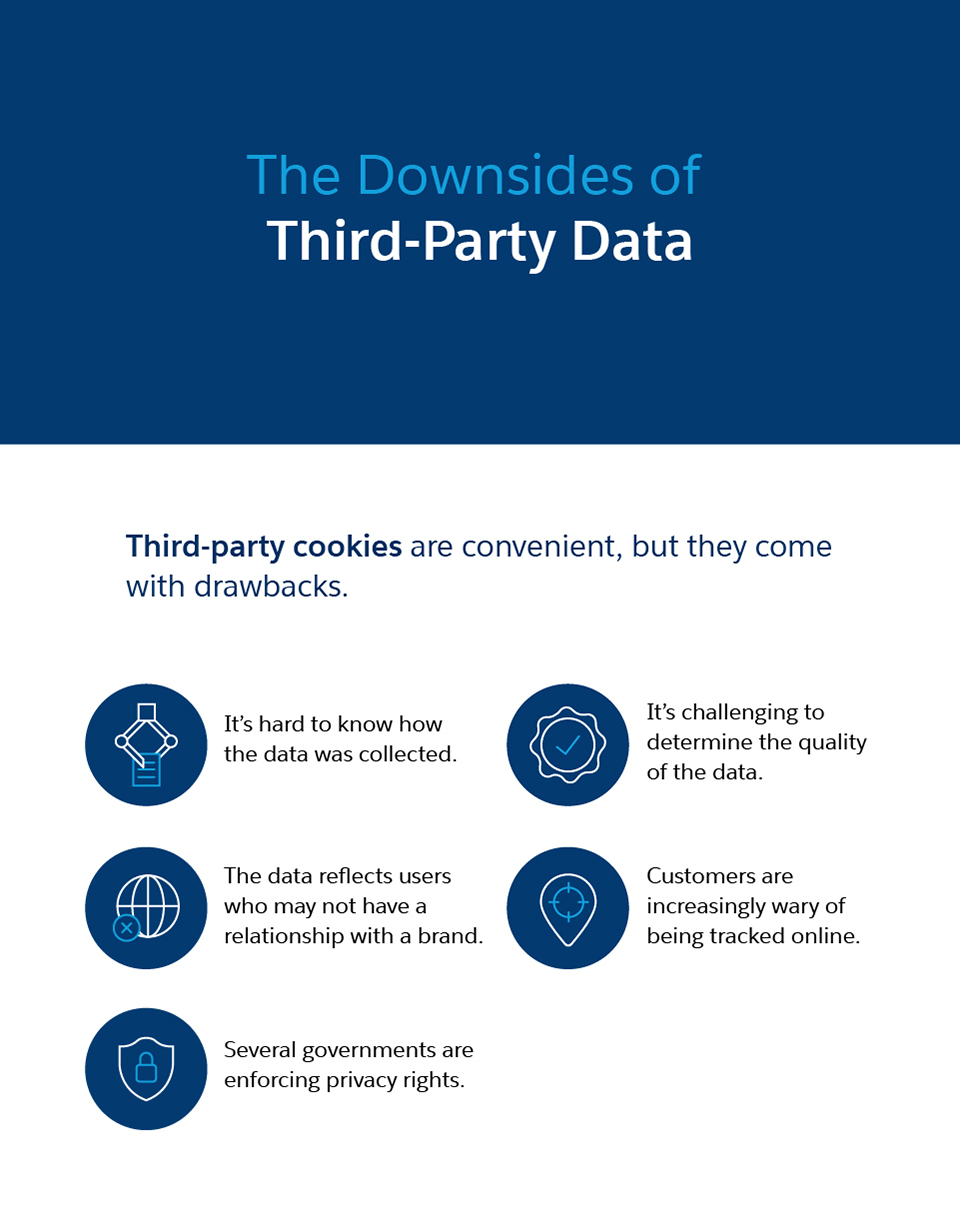For over 25 years, marketers have relied on third-party cookies to access intricately detailed information about their users. However, the cookie train will soon come to a halt. Firefox, Safari, and Apple have already dropped third-party cookies, and Google (after several delays) has announced it will phase out third-party cookies in the second half of 2024.
Is marketing as we know it over?
Not exactly. In fact, the death of third-party cookies may lead to the birth of a better, stronger marketing ecosystem. Those who depended on third-party cookies to understand their users may be in for a big wake-up call. However, those who are willing to go back to the basics and build authentic and mutually beneficial relationships with their customers may be able to thrive. Here’s what you need to know about life after third-party cookies.
First-Party Cookies vs. Third-Party Cookies
To understand how big a deal this cookie phase-out really is, it may help to get a quick cookie refresher. To start, a cookie is simply a small text file that a website places on a user’s computer. The text file assigns the computer a unique ID, allowing the cookie to track the user’s actions.
In many scenarios, cookies can be useful. Host domains use first-party cookies to improve a visitor’s experience. These cookies can make it possible for a website to remember a visitor’s username and password, remind them of an item left in their shopping cart, and recommend products based on past purchases.

Many people appreciate and even expect this level of personalization. A 2021 Harris Poll survey commissioned by Redpoint Global found that 61 per cent of respondents viewed a personalized experience as “a standard expectation for doing business with a brand.”
Consumers don’t always welcome third-party cookies the same way. Third parties, not the host domain, place these text files on websites, social media channels, and other platforms to track user activity across multiple sites and retarget advertisements. If you’ve ever looked up a specific brand of watch and then seen ads for that watch follow you around the internet, you’ve been on the receiving end of third-party cookies.
Data management companies often package and sell third-party data (the information gathered by third-party cookies) in highly precise data segments to marketers. While third-party data can allow marketers to target users on a granular level, not every consumer appreciates having their movements and information tracked across the internet.
The Problem with Third-Party Data
Marketers have long prized third-party cookies for their convenience and have eagerly purchased third-party data. After all, why spend months and years painstakingly building your own customer segments when you can buy them from a third-party data broker?
There are downsides to this tactic, however. Marketers don’t know how third-party data was collected and may struggle to determine the quality of the data. Most importantly, purchased data offers up users who may have no real relationship with the brand. All of these factors could result in poor campaign results and wasted marketing spending.

First-party data, on the other hand, is derived from direct interactions with users on the brand’s platform. A user may sign up for an account with the brand to purchase a product, download an infographic, or become a member of the brand’s club. These interactions build a relationship between the brand and the user. Brands can also clearly see how the data was collected and understand its purpose. This will allow them to create more targeted and successful campaigns.
Why Browsers Are Phasing Out Third-Party Cookies
Browsers can see the writing on the wall. Consumers are growing increasingly wary of how they are being tracked online, and several governments across the world are enforcing more privacy rights.
According to a 2020 survey by Consumer Reports, 96 per cent of respondents want companies to do more to protect consumer rights. Governments are also stepping into the fray, with the European Union enforcing the General Data Protection Regulation (GDPR) and California passing the California Consumer Privacy Act (CCPA). Both pieces of legislation require websites to give users more control in opting out of tracking. In fact, the GDPR requires proactive user consent for all but “strictly necessary” tracking.
Browsers often explain their third-party cookie bans as a means of protecting user privacy. In announcing the phase-out of third-party cookies on Chrome, Vinay Goel, Product Director of Chrome’s Privacy Sandbox, wrote, “We believe the web community needs to come together to develop a set of open standards to fundamentally enhance privacy on the web, giving people more transparency and greater control over how their data is used.”
The motives of these browsers and larger platforms may not be entirely altruistic, however. Many of the companies implementing third-party cookie bans also collect a significant amount of user data within their own ecosystems. With the bans in place, these platforms will have no problem collecting massive amounts of user data from their first-party cookies. They will likely be able to sell this data in some form, gaining a greater share of the data market.
What Does the Future Look Like for Marketers?
There’s no doubt that the dissolution of third-party cookies will represent a significant shakeup in the marketing world. According to a research report by Epsilon, about 80 per cent of marketers rely on third-party cookies. The report also found that 67 per cent of respondents “feel a combination of disappointed, frustrated, overwhelmed, helpless, and even confused by the news.”
The sky is not falling on the marketing world. While third-party cookies won’t be a data collection option by 2024, companies are already proposing new ideas. Most prominently, Google is working on a plan called Federated Learning of Cohorts, or FLoC.
According to Jackie Yeaney, Chief Marketing Officer of Tableau, “With FLoCs, user data is not sold individually to advertisers but rather in a batch with other users who share similar interests. That way marketers could theoretically target groups of soccer fans, home chefs, or expecting parents without compromising customers’ individual privacy.”
On this new playing field, marketers and advertisers need to accept that they won’t be able to access the same depth of user information as in the past. Rather than targeting users on the individual or household level, they may now need to be content with targeting consumers as an aggregated group.
While this new state of affairs will impact marketing campaigns in a variety of ways, it also presents a significant opportunity.
How to Thrive in the Post Third-Party Cookie World
As third-party cookies become less and less available, marketers must accept the challenge of identifying their users in a new way. It’s time for marketers to embrace a first-party data strategy based on building direct and genuine relationships with their customers.
Redevelop your platform
Third-party cookies were simply one of many tools marketers use to collect data. Luckily, marketers still have their most powerful data-collecting tools, mainly their existing platforms, including their websites and apps. Now is the time to refocus and redevelop these platforms to collect and store data with the full and enthusiastic consent of users.
Give users a reason to share their data
An opt-in ecosystem is only challenging when marketers have nothing of value to offer their users. Instead of seeing this situation as a negative, turn it into an opportunity to develop quality content and experiences users will be excited to sign up for.
Consider offering tiered content, VIP memberships, special discounts, or advanced access to users who are willing to give you their information in exchange.

Build relationships
Many consumers hate the idea of unknown brands tracking their movements and activities across the web, but they will eagerly sign up to receive updates and insights from their favorite brands. Relationships have always been at the heart of authentic marketing, and they’re more important now than ever.
In an article for Salesforce, Jackie Yeany put it perfectly when she wrote, “There is no magic bullet or secret ingredient to building meaningful customer relationships and developing community around a brand. You have to do it the hard way: Respect and level with your customers. Offer them something that will improve their experience with your product. The best data is the first-party data that our customers share with us willingly.”
Be honest and authentic and your customers will reward you.
Dial in your data management
A first-party data strategy demands that you implement a strong data management system. It doesn’t matter how much data you collect if you can’t easily access and evaluate that information. A flexible and robust CRM will help you best utilize the data you collect from your own platforms. This system can help you segment audiences, test different messaging, and analyze the results of marketing campaigns.
Learn how to utilize your data
Data is useless unless you know how to put it into action. Marketers can no longer get away with buying segmented data lists. Instead, they need to understand how to analyze their own internal data to make strategic marketing decisions. The marketing department can’t afford to be siloed. Instead, work across departments, including sales and IT, to better manage your data and to extract the insights you need to keep improving your process. Marketers may also need to figure out how to effectively combine their first-party data with whatever new version of third-party data becomes available.
To make sure you can collect, store, and get insights from your first-party data, consider partnering with a Customer Data Platform (CDP). A CDP combines a customer’s data from every system, channel, and data stream in real time. By integrating data from every part of the customer experience, you can make better recommendations and give your customers nearly magical, hyper-personalized service while protecting their data.
A Constantly Changing Marketing Landscape
The marketing landscape is in constant flux, and the phase-out of third-party cookies is just the latest in an ever-growing list of changes. Today’s marketers must be agile and adaptable as they face rapidly advancing technology and an ever-shifting regulatory landscape.
Companies that embrace a first-party data strategy can position themselves to forge strong and authentic relationships with their customers, which typically wasn’t possible when relying on third-party data.
In a way, today’s most forward-facing data collection strategies rely on implementing the fundamentals. It’s time to stop tracking customers behind their backs and instead invite them to be active participants in a brand’s platform. As it has always been, the best data collection strategy is about forging true, authentic connections and communities.


